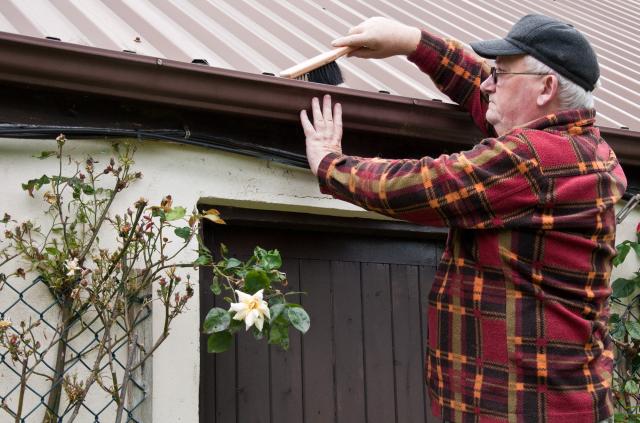
Best Gutter Cleaning Tools for DIY Homeowners - 2025 Guide
Gutter cleaning no longer requires dangerous ladder work or expensive professional services. Mode...
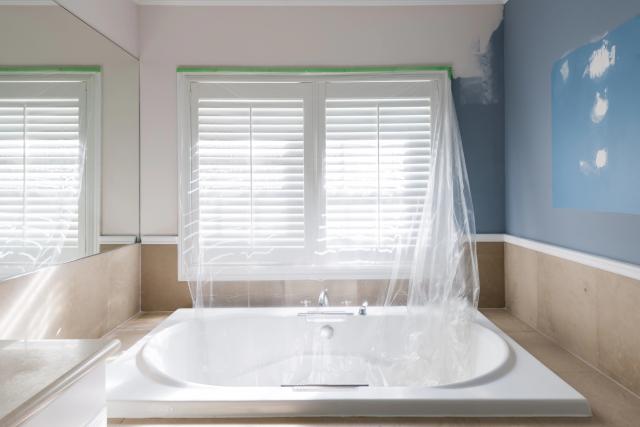
Bathroom walls face tougher conditions than any other room in your home. Steam from hot showers, constant humidity changes, and frequent cleaning create an environment where standard paint simply can't perform. The right paint sheen makes the difference between walls that stay beautiful for years and those that start peeling, molding, or staining within months. What's the best paint for bathroom walls? Semi-gloss and satin finishes work best for most bathrooms, offering excellent moisture resistance and durability while standing up to regular scrubbing. Semi-gloss provides maximum protection in high-moisture areas, while satin delivers solid performance with a softer appearance. Both create the moisture barrier your bathroom walls need to resist mold growth and water damage. Your choice depends on factors like ventilation quality, moisture levels, and how often you clean your walls. This guide covers different paints for bathrooms from flat to high-gloss, plus mold-resistant formulations and application techniques to help you choose the right finish for your specific needs.
Standard paint fails quickly in bathrooms because these spaces create conditions unlike anywhere else in your home. Humidity spikes from 0% to 100% within minutes during showers, while temperature swings of 10-30°F happen regularly. These extreme shifts cause ordinary paint to expand, contract, and ultimately fail.
Every shower or bath transforms your bathroom into a tropical environment. Regular paint can't handle these dramatic changes—it lacks the flexibility needed to move with expanding and contracting surfaces. Steam condenses directly on walls, creating water infiltration that leads to bubbling and peeling.
Impact of Bathroom Conditions on Paint Performance
|
Condition |
Effect on Standard Paint |
Effect on Bathroom Paint |
|---|---|---|
|
Daily humidity cycles |
Peeling, bubbling |
Maintains adhesion |
|
Temperature shifts |
Cracking, flaking |
Flexible bond |
|
Condensation |
Water infiltration |
Moisture barrier |
Pro Tip: Install a bathroom exhaust fan rated for your bathroom's square footage to reduce humidity cycles and extend paint life.
Bathroom walls collect more than just moisture. Hairspray, cosmetics, toothpaste splatters, and soap scum create a mix of contaminants that standard paint absorbs readily. You'll clean bathroom walls 2-4 times more often than other rooms, and each cleaning session with chemical cleaners removes microscopic paint layers.
Regular paint becomes porous over time, allowing these substances to penetrate deeply. Specific bathroom paint finishes create a sealed surface that repels contaminants instead of absorbing them. This makes cleaning more effective while protecting the paint underneath.
Bathrooms provide ideal conditions for mold development, with moisture, warmth, and organic matter. Standard paint actually feeds mold spores, allowing fungi to establish colonies that spread beneath paint layers. Black mold poses serious health risks that extend beyond aesthetic concerns.
Paints for a bathroom contain mildewcides and fungicides that actively fight microbial growth. These antimicrobial additives remain effective for years, creating an inhospitable surface for mold spores. This protection becomes critical in poorly ventilated spaces where moisture lingers longer.
Deciding on the right paint for your bathing space means thinking beyond color preferences. Factors like mold and stain-resistance, moisture seal, and durability determine whether your paint job lasts for years or starts failing within months. Consider each element when deciding which finish offers the best performance for your specific bathroom conditions.
Bathroom walls require frequent cleaning from water splashes, soap residue, and occasional mildew spots. Your paint needs to withstand regular scrubbing without fading or wearing through.
|
Feature |
Why It Matters |
What to Look For |
|---|---|---|
|
Scrub Resistance |
Determines cleaning durability |
1000+ scrub cycles rating |
|
Stain Release |
Prevents permanent marking |
"Stain-blocking" on the label |
|
Moisture Seal |
Blocks water penetration |
"Moisture-resistant" formula |
Best bathroom paints typically offer 2000+ scrub cycles before showing wear. Check the manufacturer's durability rating to compare options—higher numbers mean better cleaning resilience.
Pro Tip: Look for paints labeled "scrubbable" rather than just "washable." Scrubbable formulations withstand more aggressive cleaning without damage.
Mold-resistant paint finishes for bathrooms contain EPA-registered antimicrobial additives that actively prevent fungal growth on painted surfaces. Look for labels specifically stating "mildewcide" or "fungicide" in the formulation.
These ingredients create an inhospitable surface for mold spores. Some manufacturers add zinc oxide or other minerals that naturally resist microbial growth, providing long-term protection even in high-moisture environments.
Your bathroom paint's sheen level affects both moisture resistance and appearance. Higher sheens like semi-gloss and gloss repel water more effectively and clean more easily, but they highlight wall imperfections. Lower sheens like eggshell and satin hide imperfections better but offer less moisture protection.
The best choice depends on your bathroom's ventilation, moisture levels, and wall condition.
Modern moisture-resistant paints for bathrooms offer eco-friendly options without sacrificing performance. Look for low-VOC or zero-VOC formulations that reduce harmful emissions - particularly important in small, enclosed bathroom spaces.
Eco-friendly certifications to consider:
Water-based versions of traditionally oil-based formulations now provide comparable performance with less environmental impact. These options often dry faster and emit fewer odors during application, making them ideal for poorly ventilated bathrooms.
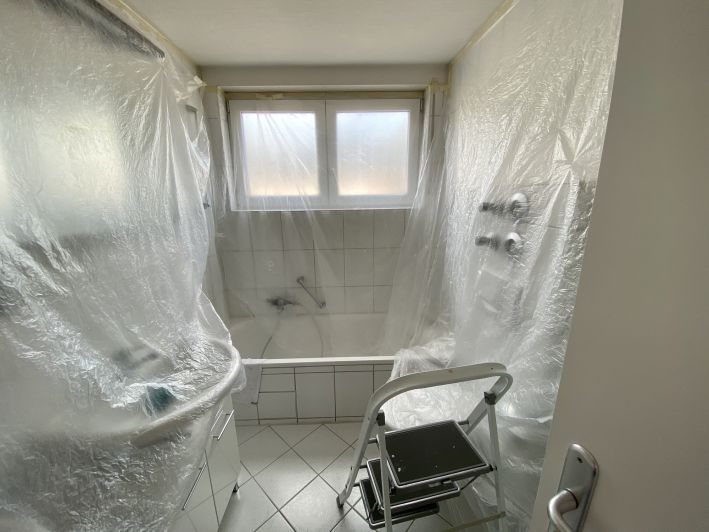
Paint sheens range from no reflection (flat) to mirror-like shine (gloss). Each level performs differently in bathroom environments:
|
Sheen Level |
Light Reflection |
Moisture Resistance |
Wall Imperfection Hiding |
|---|---|---|---|
|
Flat |
0-5% |
Poor |
Excellent |
|
Eggshell |
10-25% |
Limited |
Good |
|
Satin |
25-35% |
Moderate |
Fair |
|
Semi-gloss |
35-70% |
High |
Poor |
|
Gloss |
70-90% |
Maximum |
Very Poor |
The chemistry behind these differences matters for bathroom performance. Higher-sheen paints contain more resin and less pigment, creating a tighter molecular structure that forms an effective moisture barrier. Semi-gloss and gloss formulations withstand 3-5 times more scrubbing cycles compared to flat finishes before showing wear.
Higher sheens excel at preventing water infiltration and resist:
Lower sheens absorb moisture more readily since their porous surface allows water to penetrate easily. Flat paints particularly struggle in bathroom environments because they lack the protective resin barrier that higher sheens provide.
Your ventilation quality influences sheen selection. Poorly ventilated bathrooms require higher-sheen paints (semi-gloss or gloss) regardless of appearance preferences, since moisture management becomes the primary concern.
Pro Tip: Use semi-gloss on walls within 3 feet of water sources and satin for remaining walls to balance protection with appearance.
Not all paint sheens handle bathroom conditions equally well. The right choice determines whether your walls stay beautiful for years or need frequent touch-ups. Here are the five most common bathroom paint sheens, ranked from best to worst for moisture resistance and durability.
Bathroom Paint Sheen Performance Comparison
|
Sheen |
Moisture Resistance |
Imperfection Hiding |
Primary Use |
|---|---|---|---|
|
Semi-Gloss |
Excellent |
Poor |
Primary bathrooms |
|
Satin |
Very Good |
Fair |
Family bathrooms |
|
Gloss |
Superior |
Very Poor |
Trim, high-splash areas |
|
Eggshell |
Moderate |
Good |
Powder rooms only |
|
Flat |
Poor |
Excellent |
Avoid for bathrooms |
Semi-gloss delivers the best overall performance for bathroom walls, with 35-70% light reflection that creates a protective barrier against moisture. This finish resists mold growth, withstands frequent cleaning, and maintains its appearance through years of daily use. Semi-gloss paint handles steam, splashes, and humidity better than lower-sheen alternatives while remaining washable enough for regular maintenance.
The main drawback involves its tendency to highlight wall imperfections like nail holes, drywall seams, and surface irregularities. You'll also notice brush marks more easily with semi-gloss, requiring careful application technique.
|
Pros |
Cons |
|---|---|
|
Excellent moisture resistance |
Shows wall imperfections |
|
Easy to clean and scrub |
Reveals brush marks |
|
Resists mold growth |
Higher cost than flat paint |
|
Long-lasting durability |
Reflects more light |
Best for: Primary bathrooms with showers, family bathrooms with daily use.
Satin paint offers solid moisture protection with 25-35% light reflection, creating a subtle pearl-like finish that works well in most bathrooms. This sheen hides minor wall imperfections better than semi-gloss while still providing decent washability. Satin paint resists mold growth reasonably well and handles routine cleaning without showing wear quickly.
Satin doesn't match semi-gloss for moisture resistance, making it less suitable for poorly ventilated bathrooms or areas with heavy steam exposure.
|
Pros |
Cons |
|---|---|
|
Hides wall imperfections |
Less moisture resistant than semi-gloss |
|
Soft, appealing appearance |
May require more frequent touch-ups |
|
Good cleaning durability |
Not ideal for high-moisture areas |
|
Moderate cost |
Shows scuff marks over time |
Best for: Well-ventilated bathrooms, guest bathrooms, powder rooms with good airflow.
High-gloss paint provides maximum moisture protection with 70-90% light reflection, making it nearly impervious to water damage. This finish works exceptionally well for bathroom trim, doors, and areas around tubs and showers where water exposure is heaviest. Gloss paint cleans easily and resists staining better than any other finish.
The mirror-like shine highlights every wall flaw and can create an uncomfortably bright, institutional appearance when used on entire walls.
|
Pros |
Cons |
|---|---|
|
Maximum moisture resistance |
Extremely reflective |
|
Superior cleaning durability |
Shows every wall imperfection |
|
Excellent stain resistance |
Difficult application |
|
Long-lasting finish |
Can look institutional |
Best for: Bathroom trim, doors, high-splash zones around tubs and showers.
Eggshell paint offers 10-25% light reflection with decent wall imperfection hiding, but its moderate moisture resistance makes it risky for full bathrooms. This finish can handle light humidity but struggles with regular steam exposure and frequent cleaning. Eggshell works only in powder rooms or half-baths without showers.
Even in low-moisture applications, eggshell requires excellent ventilation to prevent premature failure.
|
Pros |
Cons |
|---|---|
|
Hides wall imperfections well |
Limited moisture resistance |
|
Soft, attractive appearance |
Poor cleaning durability |
|
Lower cost than higher sheens |
Risk of mold growth |
|
Easy application |
Short lifespan in humid conditions |
Best for: Powder rooms and half-baths without showers or tubs.
Flat paint completely lacks the protective barrier needed for bathroom environments. With 0-5% light reflection, this finish absorbs moisture readily, creating perfect conditions for mold growth. While flat paint hides wall imperfections better than any other sheen, it fails quickly in bathroom conditions and typically needs repainting within 12 months in humid environments.
|
Pros |
Cons |
|---|---|
|
Excellent imperfection hiding |
No moisture resistance |
|
Lowest cost option |
Promotes mold growth |
|
Easy touch-up application |
Poor cleaning durability |
|
Non-reflective appearance |
Frequent repainting needed |
Pro Tip: We do not recommend flat paint for any bathroom applications.
Specialized mold-resistant paint formulations actively fight fungal development on your bathroom walls, offering protection that standard paints can't match, regardless of their finish level.
Mold- and moisture-resistant paints for bathrooms contain biocides - chemical compounds that create an inhospitable surface for mold spores. These active ingredients work differently than regular paint, which only tries to seal out moisture.
Key Mold-Resistant Paint Components
|
Component |
Function |
Effectiveness Duration |
|---|---|---|
|
Alkyd resins |
Creates a harder surface barrier |
3-5 years |
|
Zinc oxide |
Natural antimicrobial mineral |
5+ years |
|
Mildewcides |
Actively kills mold spores |
2-4 years |
|
Fungicides |
Prevents fungal colonization |
3-5 years |
These ingredients create a surface environment where mold simply cannot establish itself. Rather than waiting for moisture problems to develop, mold-resistant formulations prevent microbial growth from the start.
Here are the best paint finishes for bathrooms with moisture- and mold-resistant qualities:
Pro Tip: Check the recoat time on mold-resistant paints. Many require longer drying periods between coats to allow antimicrobial additives to cure properly.
Transform standard paint for the bathroom into mold-resistant formulations with these additives:
Additives typically cost $10-20 while providing similar protection levels to pre-formulated mold-resistant paints. Pre-mixed formulations often deliver more consistent results since they're professionally calibrated, but additives work well if you already have quality paint on hand.
Best for: Homeowners wanting to upgrade their existing paint finish for the bathroom or customize mold protection levels.
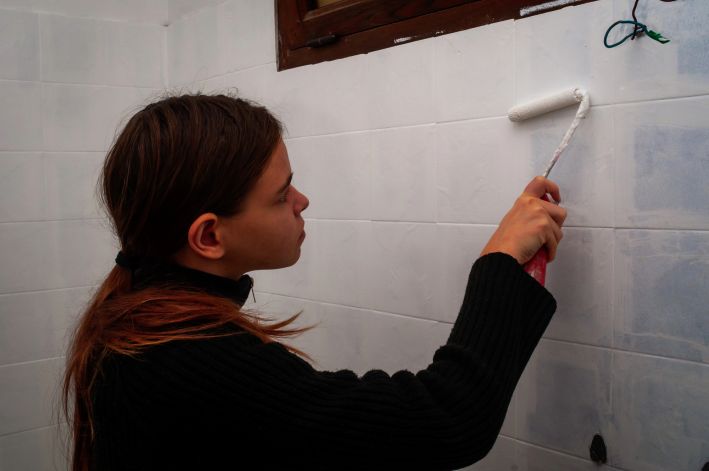
Clean bathroom walls thoroughly before painting. Use TSP (trisodium phosphate) solution to remove soap scum, body oils, and existing mildew. Sand any glossy surfaces lightly to create better paint adhesion.
Surface Preparation Steps
|
Step |
Purpose |
Tools Needed |
|---|---|---|
|
Clean with TSP |
Remove oils and residue |
Sponge, gloves, eye protection |
|
Repair damages |
Fix cracks and holes |
Spackling compound, putty knife |
|
Sand surfaces |
Create adhesion |
120-220 grit sandpaper |
|
Apply primer |
Seal surface, prevent bleed-through |
Quality primer, synthetic brush |
Prime all surfaces before applying your chosen sheen. Primer creates better adhesion and prevents stains from bleeding through your finish coat. This step becomes especially important when switching from flat to semi-gloss or satin finishes.
Pro Tip: For bathrooms with existing mold issues, use a mold-killing primer containing fungicide before applying your regular primer coat. This not only prevents mold from returning but also ensures a longer-lasting, healthier finish. If you're tackling a larger project or dealing with persistent mold problems, consider hiring professional bathroom renovation services. Experts can properly assess moisture issues, recommend mold-resistant materials, and deliver a high-quality, mold-free renovation.
Run exhaust fans and open windows during painting and for 24 hours afterward. Proper airflow prevents moisture from getting trapped between paint layers, which can cause peeling or bubbling.
Bathroom paints need longer drying times than standard paint. Allow a minimum of 4-6 hours between coats, extending to 24 hours for high-humidity bathrooms. Full curing takes approximately 2 weeks, when the paint reaches maximum hardness and washability.
Apply two coats of paint over primer for best results. Lighter colors covering darker surfaces may need three coats for complete coverage. Semi-gloss and satin finishes sometimes require additional coats to achieve a uniform appearance since these sheens show application marks more readily than flat paint.
Apply thin, even coats rather than thick applications. This prevents dripping and ensures proper curing throughout the paint depth. Higher-sheen finishes like semi-gloss reveal brush marks and roller patterns more easily, so maintain a consistent technique across each wall section.
Wait 48 hours before using bathroom fixtures after your final coat, even if surfaces feel dry. Steam from early showers can compromise paint adhesion during the critical curing period.
Quality paint and the right sheen won't save a bathroom paint job if you make critical application errors. These mistakes cause most DIY bathroom painting failures, leading to peeling, mold growth, and expensive repainting within months rather than years. Understanding these pitfalls helps you get professional painting results when applying the best paint sheen for your bathroom walls.
Poor surface preparation causes approximately 80% of bathroom paint failures. Clean surfaces, proper repairs, and quality primers create the foundation for long-lasting paint jobs.
Preparation Mistakes and Consequences
|
Common Mistake |
Consequence |
Proper Approach |
|---|---|---|
|
Not cleaning the walls |
Poor adhesion, bubbling |
Clean with TSP solution |
|
Painting over mildew |
Rapid mold regrowth |
Use mildewcide cleaner first |
|
Skipping primer |
Uneven absorption, stain bleed-through |
Apply appropriate primer |
|
Rushing between coats |
Improper curing, peeling |
Follow the manufacturer's dry time |
Many homeowners rush straight to painting without addressing existing problems. Soap scum, body oils, and mildew create barriers that prevent proper paint adhesion. Even high-quality bathroom paint fails when applied over contaminated surfaces.
Pro Tip: Use painter's tape designed specifically for bathrooms - standard masking tape fails in high-humidity environments and causes paint bleeding.
Many people choose bathroom paint finishes based on appearance rather than performance requirements. This leads to predictable problems within months of painting.
Flat paint in shower areas virtually guarantees failure. The porous surface absorbs moisture immediately, creating perfect conditions for mold growth. High-gloss paint on entire bathroom walls creates uncomfortable glare while highlighting every wall imperfection.
Bathroom ceilings need different paint than walls—typically a mold-resistant formula with lower sheen to reduce reflection. Many homeowners use the same paint everywhere, leading to ceiling problems even when the walls perform well.
Price shopping without considering quality leads to disappointing results. Premium bathroom-specific paints cost 15-30% more than standard formulations but last 3-4 times longer before requiring repainting, making them more economical in the long run.
Semi-gloss and satin finishes offer the best performance for most bathroom walls, providing the moisture resistance and durability your bathroom needs. Semi-gloss works best in high-moisture areas like shower surrounds, while satin delivers solid protection with a softer appearance for general wall areas.
Mold-resistant paint formulations make a significant difference in bathroom environments. These specialized products contain zinc oxide and mildewcides that actively fight microbial growth, extending your paint job's lifespan well beyond standard formulations. The best paints for bathroom walls cost 15-30% more than regular paint but typically last 3-4 times longer, making them more economical over time.
Your success depends heavily on proper preparation and application. Clean surfaces thoroughly, use appropriate primers, and allow adequate drying time between coats. Skipping these steps accounts for most paint failures, regardless of how premium your paint choice might be.
Consider your bathroom's specific conditions when making your final selection. Poorly ventilated bathrooms need higher-sheen options like semi-gloss, while well-ventilated spaces can use satin finishes successfully. Factor in your cleaning routine, moisture levels, and whether you prioritize appearance or maximum protection.
Choose a paint that creates an effective moisture barrier while standing up to frequent cleaning and temperature changes. The right combination of sheen selection, mold-resistant formulation, and proper application techniques will keep your bathroom walls looking great for years to come.
GET THE ESSENCE OF RELEVANT HOME
IMPROVEMENT TOPICS IN LESS THAN 5 MINUTES

Best Gutter Cleaning Tools for DIY Homeowners - 2025 Guide
Gutter cleaning no longer requires dangerous ladder work or expensive professional services. Mode...
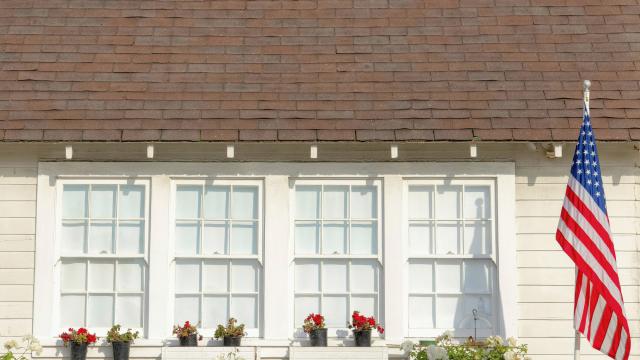
Standard window sizes make the buying process easier, faster, and more affordable for most homeow...

Thanks for joining our homeowners’ community.
Stay tuned!
Choose the category
Choose the category